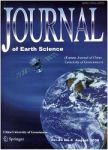Heat Shielding Effects in the Earth's Crust
Heat Shielding Effects in the Earth's Crust作者机构:School of Earth Sciences Zhejiang University Hangzhou 310027 China State Key Laboratory of Geological Processes and Mineral Resources China University of Geosciences Wuhan 430074 China Hubei Subsurface Multi-Scale lmaging Key Laboratory Institute of Geophysics and Geomatics China University of Geosciences Wuhan 430074 China Department of Earth and Atmospherie Sciences Saint Louis University St. Louis MO 63103 USA School of Earth Sciences China University of Geosciences Wuhan 430074 China
出 版 物:《Journal of Earth Science》 (地球科学学刊(英文版))
年 卷 期:2017年第28卷第1期
页 面:161-167页
核心收录:
学科分类:070801[理学-固体地球物理学] 07[理学] 0708[理学-地球物理学]
基 金:supported by the National Natural Science Foundation of China (Nos.41530319,41374079,41374060) the State Key Laboratory of Geological Processes and Mineral Resources,China University of Geosciences (No.MSFGPMR201309)
主 题:geotherm crustal laminated structure heat shielding heat conductivity peridotitic in-trusions North Tibet magnetotelluric data.
摘 要:Knowledge of heat flow and associated variations of temperature with depth is crucial for understanding how the Earth functions. Here, we demonstrate possible heat shielding effects that result from the occurrence of mafic intrusions/layers(granulitic rocks) within a dominantly granitic middle crust and/or ultramafic intrusions/layers(peridotitic rocks) within a dominantly granulitic lower crust; heat shielding is a familiar phenomenon in heat engineering and thermal metamaterials. Simple one-dimensional calculations suggest that heat shielding due to the intercalation of granitic, granulitic and peridotitic rocks will increase Moho temperatures substantially. This study may lead to a rethinking of numerous proposed lower crustal processes.



